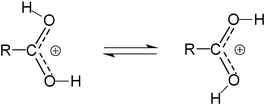Basicity of carboxylic acids: resonance in the cation and substituent effects†
Abstract
Basic properties of acetic, formic and substituted

* Corresponding authors
a
Department of Organic Chemistry, Institute of Chemical Technology, Praha 6, Czech Republic
E-mail:
bohm@vscht.cz
b
Institute of Organic Chemistry and Biochemistry, Academy of Sciences of the Czech Republic, Praha 6, Czech Republic
E-mail:
exner@uochb.cas.cz
Basic properties of acetic, formic and substituted

 Please wait while we load your content...
Something went wrong. Try again?
Please wait while we load your content...
Something went wrong. Try again?
S. Böhm and O. Exner, New J. Chem., 2005, 29, 336 DOI: 10.1039/B411039K
To request permission to reproduce material from this article, please go to the Copyright Clearance Center request page.
If you are an author contributing to an RSC publication, you do not need to request permission provided correct acknowledgement is given.
If you are the author of this article, you do not need to request permission to reproduce figures and diagrams provided correct acknowledgement is given. If you want to reproduce the whole article in a third-party publication (excluding your thesis/dissertation for which permission is not required) please go to the Copyright Clearance Center request page.
Read more about how to correctly acknowledge RSC content.
 Fetching data from CrossRef.
Fetching data from CrossRef.
This may take some time to load.
Loading related content
